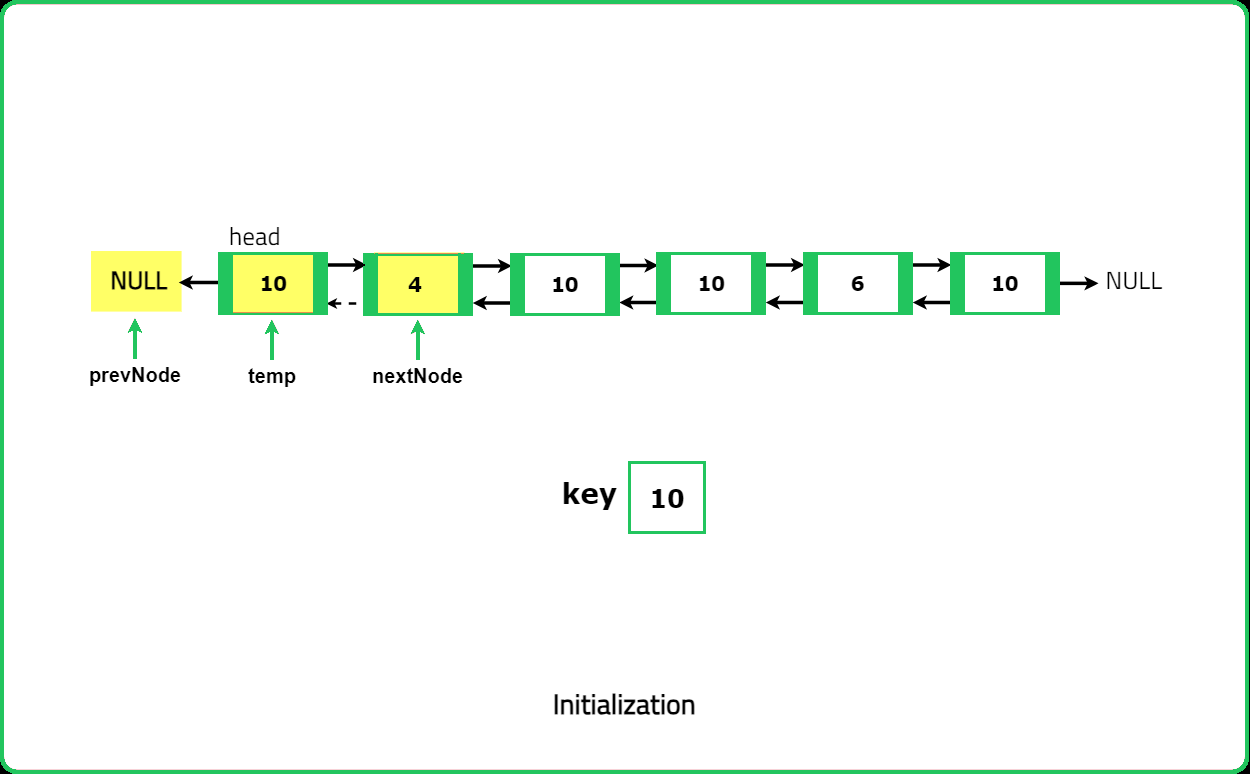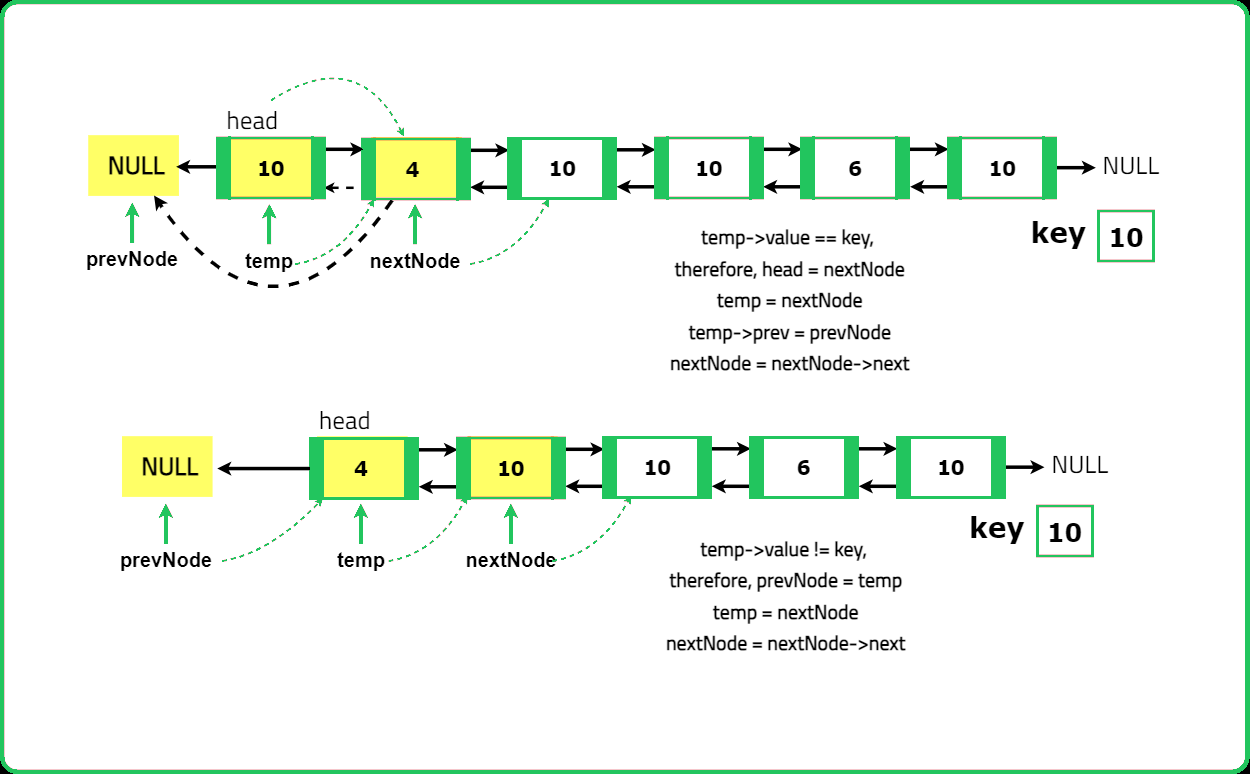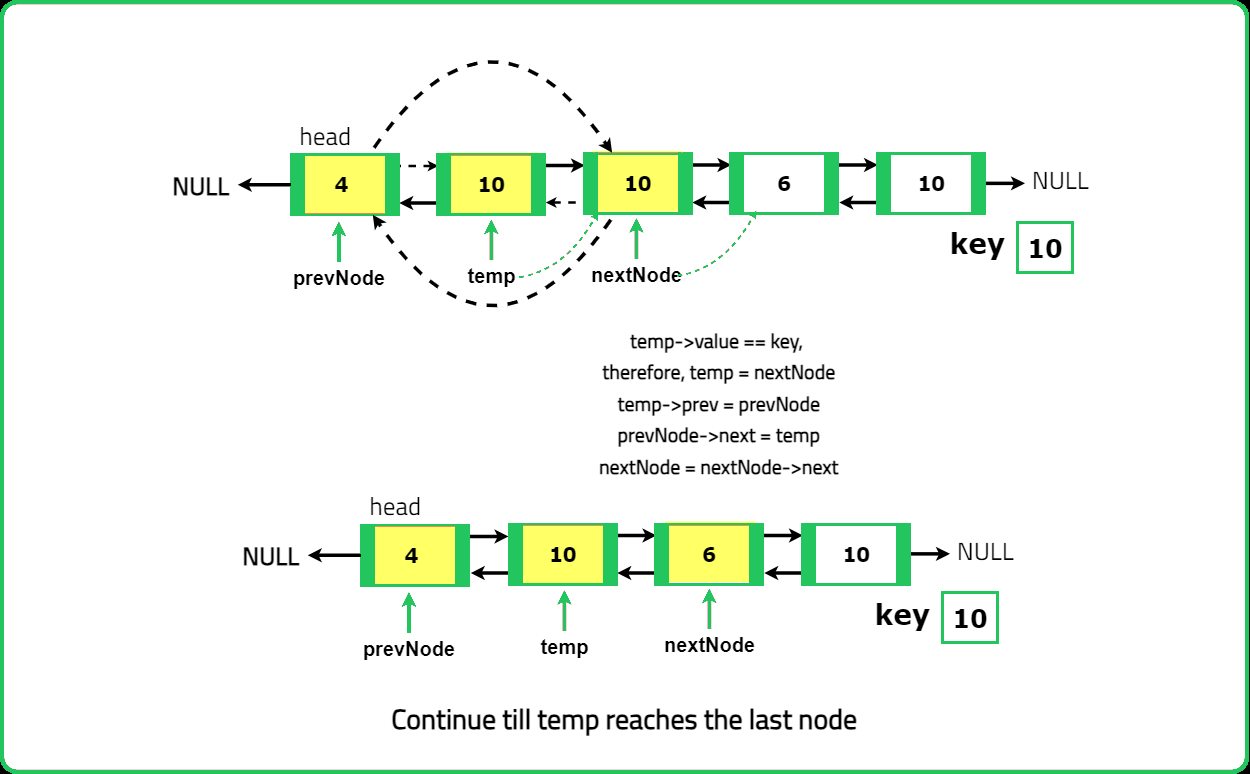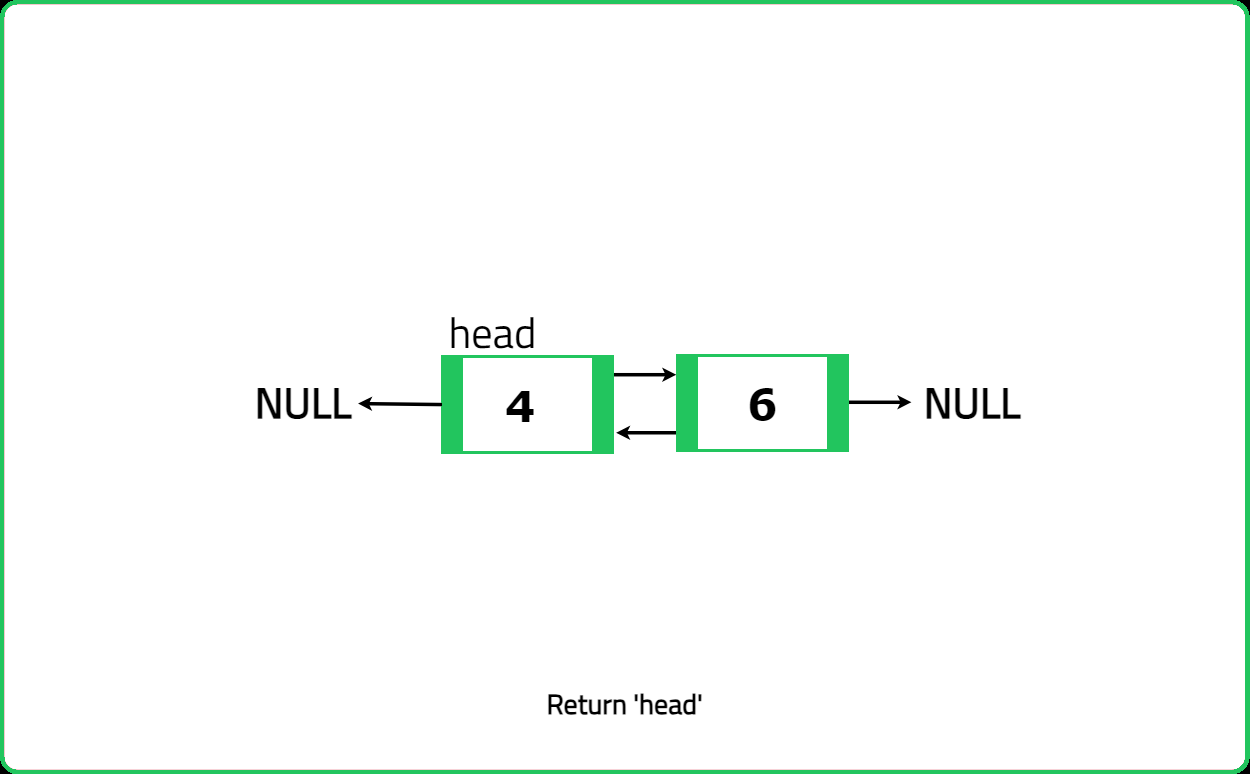123456789101112131415161718192021222324252627282930313233343536373839404142434445464748495051525354555657585960616263646566676869707172737475767778798081828384858687888990919293949596979899100101102103104105106107108109110
#include <bits/stdc++.h>
using namespace std;
// Definition of doubly linked list
struct ListNode {
int val;
ListNode* next;
ListNode* prev;
ListNode() {
val = 0;
next = NULL;
prev = NULL;
}
ListNode(int data1) {
val = data1;
next = NULL;
prev = NULL;
}
ListNode(int data1, ListNode* next1, ListNode* prev1) {
val = data1;
next = next1;
prev = prev1;
}
};
class Solution {
public:
// Function to delete all occurrences of a target value
ListNode* deleteAllOccurrences(ListNode* head, int target) {
ListNode* temp = head;
while (temp != NULL) {
if (temp->val == target) {
// Update head if needed
if (temp == head) {
head = temp->next;
}
ListNode* nextNode = temp->next;
ListNode* prevNode = temp->prev;
// Update previous node's next
if (nextNode != NULL) {
nextNode->prev = prevNode;
}
// Update next node's previous
if (prevNode != NULL) {
prevNode->next = nextNode;
}
// Delete the current node
delete temp;
temp = nextNode;
} else {
temp = temp->next;
}
}
return head;
}
};
// Function to print doubly linked list
void printList(ListNode* head) {
ListNode* temp = head;
while (temp != NULL) {
cout << temp->val << " ";
temp = temp->next;
}
cout << endl;
}
// Helper function to create a new node
ListNode* newNode(int data) {
ListNode* node = new ListNode(data);
return node;
}
int main() {
// Creating doubly linked list
ListNode* head = newNode(1);
head->next = newNode(2);
head->next->prev = head;
head->next->next = newNode(3);
head->next->next->prev = head->next;
head->next->next->next = newNode(2);
head->next->next->next->prev = head->next->next;
head->next->next->next->next = newNode(4);
head->next->next->next->next->prev = head->next->next->next;
head->next->next->next->next->next = newNode(2);
head->next->next->next->next->next->prev = head->next->next->next->next;
head->next->next->next->next->next->next = newNode(5);
head->next->next->next->next->next->next->prev = head->next->next->next->next->next;
// Print original list
cout << "Original list: ";
printList(head);
// Delete all occurrences of 2
Solution sol;
head = sol.deleteAllOccurrences(head, 2);
// Print modified list
cout << "Modified list: ";
printList(head);
return 0;
}
123456789101112131415161718192021222324252627282930313233343536373839404142434445464748495051525354555657585960616263646566676869707172737475767778798081828384858687888990919293949596979899100101102103104105106
import java.util.*;
// Definition of doubly linked list
class ListNode {
int val;
ListNode next;
ListNode prev;
ListNode() {
val = 0;
next = null;
prev = null;
}
ListNode(int data1) {
val = data1;
next = null;
prev = null;
}
ListNode(int data1, ListNode next1, ListNode prev1) {
val = data1;
next = next1;
prev = prev1;
}
}
class Solution {
// Function to delete all occurrences of a target value
public ListNode deleteAllOccurrences(ListNode head, int target) {
ListNode temp = head;
while (temp != null) {
if (temp.val == target) {
// Update head if needed
if (temp == head) {
head = temp.next;
}
ListNode nextNode = temp.next;
ListNode prevNode = temp.prev;
// Update previous node's next
if (nextNode != null) {
nextNode.prev = prevNode;
}
// Update next node's previous
if (prevNode != null) {
prevNode.next = nextNode;
}
// Delete the current node
temp = nextNode;
} else {
temp = temp.next;
}
}
return head;
}
}
// Function to print doubly linked list
public class Main {
public static void printList(ListNode head) {
ListNode temp = head;
while (temp != null) {
System.out.print(temp.val + " ");
temp = temp.next;
}
System.out.println();
}
// Helper function to create a new node
public static ListNode newNode(int data) {
return new ListNode(data);
}
public static void main(String[] args) {
// Creating doubly linked list
ListNode head = newNode(1);
head.next = newNode(2);
head.next.prev = head;
head.next.next = newNode(3);
head.next.next.prev = head.next;
head.next.next.next = newNode(2);
head.next.next.next.prev = head.next.next;
head.next.next.next.next = newNode(4);
head.next.next.next.next.prev = head.next.next.next;
head.next.next.next.next.next = newNode(2);
head.next.next.next.next.next.prev = head.next.next.next.next;
head.next.next.next.next.next.next = newNode(5);
head.next.next.next.next.next.next.prev = head.next.next.next.next.next;
// Print original list
System.out.print("Original list: ");
printList(head);
// Delete all occurrences of 2
Solution sol = new Solution();
head = sol.deleteAllOccurrences(head, 2);
// Print modified list
System.out.print("Modified list: ");
printList(head);
}
}
12345678910111213141516171819202122232425262728293031323334353637383940414243444546474849505152535455565758596061626364656667686970717273747576
# Definition of doubly linked list
class ListNode:
def __init__(self, val=0, next=None, prev=None):
self.val = val
self.next = next
self.prev = prev
class Solution:
# Function to delete all occurrences of a target value
def deleteAllOccurrences(self, head, target):
temp = head
while temp is not None:
if temp.val == target:
# Update head if needed
if temp == head:
head = temp.next
nextNode = temp.next
prevNode = temp.prev
# Update previous node's next
if nextNode is not None:
nextNode.prev = prevNode
# Update next node's previous
if prevNode is not None:
prevNode.next = nextNode
# Delete the current node
temp = nextNode
else:
temp = temp.next
return head
# Function to print doubly linked list
def printList(head):
temp = head
while temp is not None:
print(temp.val, end=" ")
temp = temp.next
print()
# Helper function to create a new node
def newNode(data):
return ListNode(data)
if __name__ == "__main__":
# Creating doubly linked list
head = newNode(1)
head.next = newNode(2)
head.next.prev = head
head.next.next = newNode(3)
head.next.next.prev = head.next
head.next.next.next = newNode(2)
head.next.next.next.prev = head.next.next
head.next.next.next.next = newNode(4)
head.next.next.next.next.prev = head.next.next.next
head.next.next.next.next.next = newNode(2)
head.next.next.next.next.next.prev = head.next.next.next.next
head.next.next.next.next.next.next = newNode(5)
head.next.next.next.next.next.next.prev = head.next.next.next.next.next
# Print original list
print("Original list: ", end="")
printList(head)
# Delete all occurrences of 2
sol = Solution()
head = sol.deleteAllOccurrences(head, 2)
# Print modified list
print("Modified list: ", end="")
printList(head)
1234567891011121314151617181920212223242526272829303132333435363738394041424344454647484950515253545556575859606162636465666768697071727374757677787980818283848586878889
// Definition of doubly linked list
class ListNode {
constructor(val = 0, next = null, prev = null) {
this.val = val;
this.next = next;
this.prev = prev;
}
}
class Solution {
// Function to delete all occurrences of a target value
deleteAllOccurrences(head, target) {
let temp = head;
while (temp !== null) {
if (temp.val === target) {
// Update head if needed
if (temp === head) {
head = temp.next;
}
let nextNode = temp.next;
let prevNode = temp.prev;
// Update previous node's next
if (nextNode !== null) {
nextNode.prev = prevNode;
}
// Update next node's previous
if (prevNode !== null) {
prevNode.next = nextNode;
}
// Move to the next node
temp = nextNode;
} else {
temp = temp.next;
}
}
return head;
}
}
// Function to print doubly linked list
function printList(head) {
let temp = head;
while (temp !== null) {
process.stdout.write(temp.val + " ");
temp = temp.next;
}
console.log();
}
// Helper function to create a new node
function newNode(data) {
return new ListNode(data);
}
(function() {
// Creating doubly linked list
let head = newNode(1);
head.next = newNode(2);
head.next.prev = head;
head.next.next = newNode(3);
head.next.next.prev = head.next;
head.next.next.next = newNode(2);
head.next.next.next.prev = head.next.next;
head.next.next.next.next = newNode(4);
head.next.next.next.next.prev = head.next.next.next;
head.next.next.next.next.next = newNode(2);
head.next.next.next.next.next.prev = head.next.next.next.next;
head.next.next.next.next.next.next = newNode(5);
head.next.next.next.next.next.next.prev = head.next.next.next.next.next;
// Print original list
process.stdout.write("Original list: ");
printList(head);
// Delete all occurrences of 2
let sol = new Solution();
head = sol.deleteAllOccurrences(head, 2);
// Print modified list
process.stdout.write("Modified list: ");
printList(head);
})();



